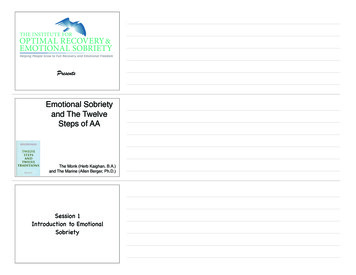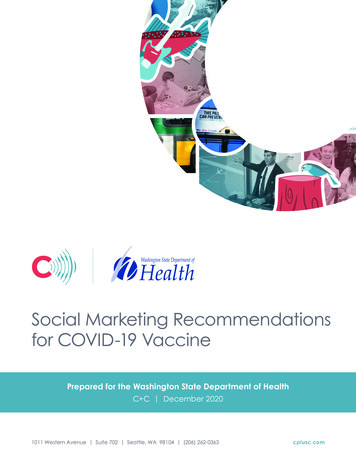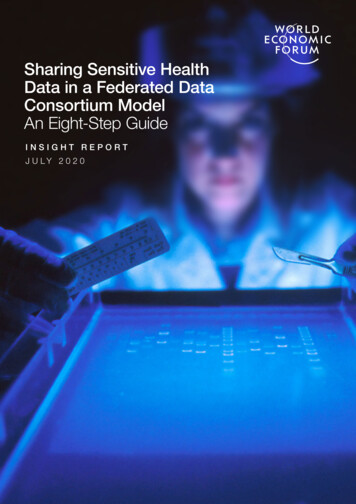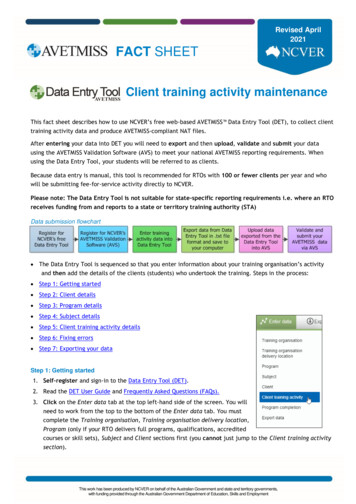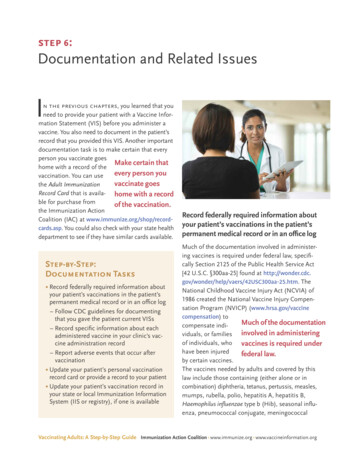
Transcription
step ₆:Documentation and Related IssuesIn the previous chapters, you learned that youneed to provide your patient with a Vaccine Information Statement (VIS) before you administer avaccine. You also need to document in the patient’srecord that you provided this VIS. Another importantdocumentation task is to make certain that everyperson you vaccinate goesMake certain thathome with a record of theevery person youvaccination. You can usevaccinate goesthe Adult ImmunizationRecord Card that is availa- home with a recordble for purchase fromof the vaccination.the Immunization ActionCoalition (IAC) at www.immunize.org/shop/recordcards.asp. You could also check with your state healthdepartment to see if they have similar cards available.Step-by-Step:Documentation Tasks Record federally required information aboutyour patient’s vaccinations in the patient’spermanent medical record or in an office log– Follow CDC guidelines for documentingthat you gave the patient current VISs– Record specific information about eachadministered vaccine in your clinic's vaccine administration record– Report adverse events that occur aftervaccination Update your patient’s personal vaccinationrecord card or provide a record to your patient Update your patient’s vaccination record inyour state or local Immunization InformationSystem (IIS or registry), if one is availableRecord federally required information aboutyour patient’s vaccinations in the patient’spermanent medical record or in an office logMuch of the documentation involved in administering vaccines is required under federal law, specifically Section 2125 of the Public Health Service Act[42 U.S.C. §300aa-25] found at -25.htm. TheNational Childhood Vaccine Injury Act (NCVIA) of1986 created the National Vaccine Injury Compensation Program (NVICP) (www.hrsa.gov/vaccinecompensation) toMuch of the documentationcompensate individuals, or families involved in administeringof individuals, who vaccines is required underhave been injuredfederal law.by certain vaccines.The vaccines needed by adults and covered by thislaw include those containing (either alone or incombination) diphtheria, tetanus, pertussis, measles,mumps, rubella, polio, hepatitis A, hepatitis B,Haemophilus influenzae type b (Hib), seasonal influenza, pneumococcal conjugate, meningococcalVaccinating Adults: A Step-by-Step Guide Immunization Action Coalition www.immunize.org www.vaccineinformation.org
88 step 6:Documentation and Related IssuesEven though the term “childhood” is in the titleof the National Childhood Vaccine Injury Act,the law includes certain vaccines wheneverthey are given to infants, children, AND adults.(ACWY and B), human papillomavirus (HPV), orvaricella (chickenpox). Even though the term“childhood” is in the title of the Act, the law includesthese vaccines whenever they are given to infants,children, AND adults.Under the law, there are three main requirementsof vaccination providers. You must: Give the patient a copy of the relevant federalVaccine Information Statement (VIS), found atwww.immunize.org/vis, for the vaccine he or sheis about to receive. Record certain information about the administered vaccine(s) in the patient’s medical record ora permanent office log. Document any adverse event that the patientexperiences following the vaccination and thatbecomes known to the provider, whether or notyou think the vaccine caused the event. Submit thereport to the Vaccine Adverse Event ReportingSystem (VAERS) at https://vaers.hhs.gov/index.Now we’ll cover the details about complying withthese three requirements.Follow CDC guidelines for documenting thatyou gave the patient current VISsThe Centers for Disease Control and Prevention(CDC) is responsible for developing the VISs andupdating them when necessary. Each VIS containsspecific information about the disease the vaccineprevents, the vaccine, possible side effects, whatto do about serious reactions, and the phone numbers of the National Vaccine Injury CompensationThe patient mustalways be offereda copy of the VISto take home.Program and the VaccineAdverse Event ReportingSystem. VISs are availablefrom CDC at www.cdc.gov/vaccines/hcp/vis/index.htmlor IAC at www.immunize.org/vis. The IAC VISwebsite is the source for VISs in many languagesin addition to English.Be sure to review CDC’s Instructions for the Useof Vaccine Information Statements located nstructions.pdf, as well as IAC’s It’s Federal Law!You must give your patients current Vaccine Information Statements (VISs), available at www.immunize.org/catg.d/p2027.pdf. Remember, “providing” aVIS typically means giving your patients a physicalcopy to take home. They can, however, reviewa laminated or electronic version – but the patientmust always be offered a copy to take home. Besure to give the VIS to the patient BEFORE youvaccinate, allowing them enough time to read it.Confirm that you are using the most current versionof the VIS by checking the listing of current VIS dateson the IAC website at www.immunize.org/vis.Vaccinating Adults: A Step-by-Step Guide Immunization Action Coalition www.immunize.org www.vaccineinformation.org
step 6:Documentation and Related Issues89Record specific information about eachadministered vaccine in your clinic’s vaccineadministration recordevents and unusual increases in previously reportedevents. Both FDA and CDC review data that arereported to VAERS.A second federal requirement calls for the providerto record certain information about the vaccinesadministered. This information may be recordedin the patient’s permanent medical record or in apermanent clinic log. The information requiredincludes:All healthcare providers and vaccine manufacturersare required to report post-vaccination adverseevents listed in the VAERS Table of Reportable EventsFollowing Vaccination found at https://vaers.hhs.gov/docs/VAERS Table of Reportable Events FollowingVaccination.pdf. Reports must be made whether ornot the provider thinks the vaccine caused the event.Anyone, including vaccine recipients themselves,may submit a report. Healthcare providers shouldsubmit VAERS reports online on the VAERS websiteat https://vaers.hhs.gov/index. date the vaccination was given; vaccine manufacturer and lot number of the vaccine administered; name, address (location where the informationwill be stored), and title of the individual whoadministered the vaccine;https://vaers.hhs.gov/index edition (date of publication) of the VIS (found atthe bottom of the back page of the VIS*); and date the VIS was given to the patient.* Each VIS also contains a barcode that allows the editiondate to be scanned into the record, with the proper software.IAC’s Vaccine Administration Record for Adults, apaper form suitable for use in a patient’s medicalchart, simplifies and organizes the information thatmust be documented. This form, which is availableat www.immunize.org/catg.d/p2023.pdf, also provides examples of how you might fill in the form.In addition, most electronic health records containspace to record this information electronically.Report adverse events that occurafter vaccinationThe Vaccine Adverse Event Reporting System (VAERS),located at https://vaers.hhs.gov/index, serves asa national database that gathers reports of adverseevents that occur following immunizations. It provides a tool used by the Food and Drug Administration (FDA) and CDC to look for patterns of eventsfollowing vaccine administration. VAERS attemptsto detect previously unrecognized vaccine-relatedThe Vaccine Adverse Event Reporting System(VAERS) serves as a national database thatgathers reports of adverse events that occurfollowing immunizations.Update your patient’s personal vaccinationrecord card or provide a record to your patientIn Step 4: Deciding Whom to Vaccinate, we coveredhow to establish your patient’s vaccination history.Once you have determined previous vaccinations(or lack thereof), be sure to note them on the immunization record you keep in your patient’s chartVaccinating Adults: A Step-by-Step Guide Immunization Action Coalition www.immunize.org www.vaccineinformation.org
90 step 6:Documentation and Related Issuesand/or in their electronic health record. Include inthe record as much information as you’ve been ableto find, even if it’s incomplete. The most importantelements to include are the type of vaccine and thedate it was given (month, day, and year). Don’tworry about not having all or any of the other information (such as the manufacturer and lot number)about vaccines that were given elsewhere. Thatinformation likely will have been recorded in theoriginal clinic’s records.Healthcare professionalor clinic nameDate nextdose dueAlways carry this record with you and have yourhealthcare professional or clinic keep it up to date.M.I.First nameMeningococcalOther(yr.)(HPV2, HPV4,HPV9)(MenACWY [MCV4],MenB, MPSV4)–(whooping cough)(Tdap,Td)First s(day)Zoster (shingles)(IIV, LAIV)–InfluenzaDate nextdose dueLast name(chickenpox) (Var)(mo.)Healthcare professionalor clinic nameIf comboMeasles, Mumps,Rubella (MMR)VaricellaBirthdate:(PCV13, PPSV23)M.I.Healthcare provider: List the mo/day/yr for each vaccination given. Record thegeneric abbreviation (e.g., PPSV23) or the trade name. For combination vaccines(i.e., HepA–HepB), fill in a row for each separate antigen in the combination.VaccinePneumococcalADULT IMMUNIZATION RECORDDate givenmo/day/yrLast nameType ofvaccineHepatitis A(HepA, HepA-HepB)Type ofDate givenvaccinemo/day/yrImmunization Action MedicalCoalition notesSaint Paul,Minn. www.immunize.org(e.g.,allergies,vaccine reactions):To order additional record cards, visit www.immunize.org/shop Item #R2005 (3/16)VaccineHepatitis B(HepB, HepA-HepB)PatientNumber:Don’t forget to give the patient a record of the vaccination that he or she just received. If he or shehas a personal record card, you can simply updateit. If not, you can print out your patient’s immunization record from your electronic medical recordsystem, give the patient an Adult ImmunizationRecord Card, available at www.immunize.org/shop/record-cards.asp, or provide a similar documentafter you’ve filled in the information. This recordalso should include acolumn to indicatewhen the next dose isdue; you should complete this column forthe patient. This is particularly important forwww.immunize.org/vaccines that are givenshop/record-cards.aspmore than once (e.g.,Td, hepatitis A, hepatitis B, varicella, and HPV).To learn more about vaccines, visit www.vaccineinformation.orgIf you are not the primary care provider, it’s alsoimportant that you provide information about thevaccinations just administered to the patient’sprimary care provider. Remind the patient to havetheir primary care clinic update the clinic medicalrecord from the information on the patient’s personalimmunization record card. You can offer to providethe information for the patient if she or he can giveyou the primary care clinic’s name and address.To assist with this, IAC’s Notification of VaccinationLetter Template is available at www.immunize.org/catg.d/p3060.pdf.Update your patient’s vaccination record inyour state or local Immunization InformationSystem (IIS, or registry), if one is availableAn IIS (“registry”) is a confidential computerizeddatabase that records all vaccine doses administeredby participating providers to persons residingwithin a given area, usually a county or state. AtAn IIS can provide a consolidated immunizationhistory to determine what vaccinations a patientneeds now and during future visits.the time ofthis writing, thereis no nationwidedatabase of individual vaccination records. Inyour clinic orcdcoffice, an IIS can provide a consolidated immunization history to determine which vaccinations apatient needs now and during future visits. Thiscan eliminate the need to call other offices forrecords or have the patient search for his/her ownwritten record. Having a complete vaccination history also will reduce missed opportunities to vaccinate and reduce duplicate vaccinations. Many IISscan accept data directly from an electronic healthrecord, eliminating the need to enter the same vaccination data twice.We strongly suggest that you participate in an IISif one is available in your area. Contact the appropriate State/Territory/City Registry Staff for information about participating in your IIS. A list of staffin your area is available at y-staff.html.That’s it! Although properly documenting vaccinations is not complex, it is a critical part of the patient’smedical record. Don’t miss this important step.Vaccinating Adults: A Step-by-Step Guide Immunization Action Coalition www.immunize.org www.vaccineinformation.org
step 6:Documentation and Related Issues91step ⁶: documentation and related issuesMaterials and Resources for You to Use Tools for ProvidersInstructions for the Use of Vaccine InformationStatements (CDC) – structions.pdfIt’s Federal Law! You Must Give Your PatientsCurrent Vaccine Information Statements n of Vaccination Letter Template (IAC)www.immunize.org/catg.d/p3060.pdfVaccine Administration Record for Adults (IAC)www.immunize.org/catg.d/p2023.pdfVaccine Information Statements (VISs) and Translations (IAC) – www.immunize.org/visnote: The publisher of each resource is shown as an acronymin the parentheses following the title. A key to these acronymsis included in Appendix A: Acronyms and Abbreviations. Additional Provider ResourcesCurrent Dates of Vaccine Information Statements(IAC) – www.immunize.org/catg.d/p2029.pdfIIS State/Territory/City Registry Staff – Main andTechnical Contacts (CDC) – y-staff.htmlNational Vaccine Injury Compensation Program(HRSA) – www.hrsa.gov/vaccinecompensationVaccine Adverse Event Reporting System (VAERS)(HHS) – https://vaers.hhs.gov/index Information for PatientsAdult Immunization Record Card (IAC)www.immunize.org/shop/record-cards.asp General InformationImmunization Action Coalition (IAC)www.immunize.orgVaccinating Adults: A Step-by-Step Guide Immunization Action Coalition www.immunize.org www.vaccineinformation.org
92 step 6:Documentation and Related IssuesTo access the current, ready-to-copy version of this piece, visitwww.immunize.org/catg.d/p2027.pdfIt’s Federal Law! You must giveyour patients current VaccineInformation Statements (VISs)What are Vaccine Information Statements (VISs)?Top 10 Facts About VISsfact1Federal law requires that VISs must be used for patients ofall ages when administering these vaccines:DTaP (includes DT)Td and TdapHibhepatitis Ahepatitis BHPVLQƬXHQ]D LQDFWLYDWHG and live, intranasal)Vaccine Information Statements (VISs) are documents producedby the Centers for Disease Control and Prevention (CDC), in consultation with panels of experts and parents, to properly inform vaccinees (or their parents/legal representatives) about the risks andEHQHƫWV RI HDFK YDFFLQH 9,6V DUH QRW PHDQW WR UHSODFH LQWHUDFWLRQVwith health care providers, who should address any questions orconcerns that the vaccinee (or parent/OHJDO UHSUHVHQWDWLYH PD\ KDYH Federal law (under the National Childhood Vaccine Injury Act)requires a health care provider to give a copy of the current VIS toan adult patient or to a child’s parent/legal representative beforevaccinating an adult or child with a dose of the following vaccines:diphtheria, tetanus, pertussis, measles, mumps, rubella, polio,hepatitis A, hepatitis B, DHPRSKLOXV LQƬXHQ]DH W\SH E LE LQƬX enza, pneumococcal conjugate, meningococcal, rotavirus, humanSDSLOORPDYLUXV 39 RU YDULFHOOD FKLFNHQ SR[ Where to get VISsAll available VISs can be downloaded from the websites of the,PPXQL]DWLRQ FWLRQ &RDOLWLRQ DW ZZZ LPPXQL]H RUJ YLV RU &'& DWZZZ FGF JRY YDFFLQHV KFS YLV LQGH[ KWPO 5HDG\ WR FRS\ YHUVLRQV PD\ DOVR EH DYDLODEOH IURP \RXU VWDWH RU ORFDO KHDOWK GHSDUWPHQW Translations: RX FDQ ƫQG 9,6V LQ PRUH WKDQ 30 languages on theImmunization Action Coalition website at ZZZ LPPXQL]H RUJ YLV To obtain translations of VIS in languages other thanEnglish, go to www.immunize.org/vis.According to CDC, the appropriate VIS must be given:Ĺ Priorto the vaccination (and prior to each dose of amulti-dose series);Ĺ 5HJDUGOHVV RI WKH DJH RI WKH YDFFLQHHĹ 5HJDUGOHVV RI ZKHWKHU WKH YDFFLQH LV JLYHQ LQ D SXEOLF RU SULYDWH KHDOWK FDUH VHWWLQJ 005 DQG 0059meningococcal (MenACWY, MenB)pneumococcal conjugatepoliorotavirusvaricella (chickenpox)For the vaccines not covered under the National Childhood Vaccine,QMXU\ FW L H DGHQRYLUXV DQWKUD[ -DSDQHVH HQFHSKDOLWLV SQHXmococcal polysaccharide, rabies, shingles, typhoid, and yellowfever), providers are not required by federal law to use VISs unlessWKH\ KDYH EHHQ SXUFKDVHG XQGHU &'& FRQWUDFW RZHYHU &'& UHFRPPHQGV WKDW 9,6V EH XVHG ZKHQHYHU WKHVH YDFFLQHV DUH JLYHQ )HGHUDO ODZ DOORZV XS WR PRQWKV IRU D QHZ 9,6 WR EH XVHG fact2VISscan beLaw!givento Mustpatientsin Youra varietyof ways.It’sFederalYouGivePatientsCurrent Vaccine Information Statements (VISs) (continued)In most medical settings, VISs are provided to patients (or theirparents/OHJDO UHSUHVHQWDWLYHV LQ SDSHU IRUP RZHYHU 9,6V DOVR (For information on special circumstances involving vaccinationPD\ EH SURYLGHG XVLQJ HOHFWURQLF PHGLD 5HJDUGOHVV RI WKH IRUPDW of a child when a parent/legal representative is not availableXVHG WKH JRDO LV WR SURYLGH D FXUUHQW 9,6 MXVW SULRU WR YDFFLQDWLRQ at the time of vaccination, see CDC’sFrequentlyAskedQuestionscontinuedon nextpageDW ZZZ FGF JRY YDFFLQHV KFS YLV DERXW YLV IDTV KWPO Using VISs is legally required!It’s federal law! You must give current* VISsto all your patients before vaccinating them.to vaccination,may be:Most PriorcurrentversionsVISof VISs(table)Provided as a paper copy2ƪHUHG RQ D SHUPDQHQW ODPLQDWHG RƭFH FRS\by the ovirus 6/11/14 4/20/12 to aMMRsmartphone or other electronic device (VISs have been speciallyAnthrax 3/10/10MMRV 5/21/10formatted for this purpose)ChickenpoxMulti-vaccine 11/5/15 3/13/080DGH DYDLODEOH WR EH UHDG EHIRUH WKH RƭFH YLVLW H J E\ JLYLQJ Cholera PCV13the patient or7/6/17parent a copyto takehome during11/5/15a prior visit, orDTaP PPSV 4/24/155/17/07WHOOLQJ WKHP KRZ WR GRZQORDG RU YLHZ D FRS\ IURP WKH ,QWHUQHW 7KHVH SDWLHQWV PXVW VWLOO EH RƪHUHG D FRS\ LQ RQH RI WKH IRUPDWV Hib 4/2/15Polio 7/20/16describedpreviously to readduringthe immunization visit, as 7/20/16 10/6/09Hepatitis ARabiesD UHPLQGHU Hepatitis B 7/20/16Rotavirus 4/15/155HJDUGOHVV RI WKH ZD\ WKH SDWLHQW LV JLYHQ WKH 9,6 WR UHDG SURYLGHUVHPV Shingles 10/6/0912/2/16PXVW VWLOO RƪHU D FRS\ ZKLFK FDQ EH DQ HOHFWURQLF FRS\ RI HDFK ,QƬXHQ]D 8/7/15Td 4/11/17DSSURSULDWH 9,6 WR WDNH KRPH IROORZLQJ WKH YDFFLQDWLRQ RZHYHU JapaneseWKH YDFFLQHH PD\ GHFOLQH enceph 1/24/14Tdap 2/24/15MenACWY 3/31/16Typhoid 5/29/12MenB Yellowfeverpublic 3/30/11are requiredin bothandprivatefact VISs8/9/16As of July 6, 2017, the most recent versions of the VISs are as follows:3WRU VHWWLQJV UHJDUGOHVV RI WKH VRXUFH RI SD\PHQW IRU WKH YDFFLQH factYou must provide a current VIS before a vaccineTechnical content reviewed by the Centers for Disease Control and Prevention4Saint Paul, Minnesota 651- 647- 9009 www.immunize.org www.vaccineinformation.orgis administered to the patient.ZZZ LPPXQL]H RUJ FDWJ G p202 SGI Item #P2027 (7/17)A VIS provides information about the disease and the vaccine andmust be given to the patient before D YDFFLQH LV DGPLQLVWHUHG It is also acceptable to hand out the VIS well before administeringYDFFLQHV H J DW D SUHQDWDO YLVLW RU DW ELUWK IRU YDFFLQHV DQ LQIDQW will receive during infancy), as long as you still provide a current9,6 ULJKW EHIRUH DGPLQLVWHULQJ YDFFLQHV fact5You must provide a current VIS for each doseof vaccine you administer.The most current VIS must be provided before each dose of vaccineLV JLYHQ LQFOXGLQJ YDFFLQHV JLYHQ DV D VHULHV RI GRVHV )RU H[DPSOH LI GRVHV RI D VLQJOH YDFFLQH DUH UHTXLUHG H J 'TaP), the patient(parent/legal representative) must have the opportunity to readWKH LQIRUPDWLRQ RQ WKH 9,6 EHIRUH HDFK GRVH LV JLYHQ fact6The Multi-Vaccine VIS may be used in place of the individual VISs forDTaP, Hib, hepatitis B, polio, and pneumococcal when two or moreRI WKHVH YDFFLQHV DUH DGPLQLVWHUHG GXULQJ WKH VDPH YLVLW ,W PD\ EH XVHG IRU LQIDQWV DV ZHOO DV FKLOGUHQ WKURXJK \HDUV RI DJH 7KH 0XOWL 9DFFLQH 9,6 VKRXOG QRW EH XVHG IRU DGROHVFHQWV RU DGXOWV fact7You must provide VISs whenever you administercombination vaccines.If you administer a combination vaccine that does not have aVWDQG DORQH 9,6 H J .LQUL[ 4XDGUDFHO 3HGLDUL[ 3HQWDFHO Twinrix)you should provide the patient with individual VISs for the compoQHQW YDFFLQHV RU XVH WKH 0XOWL 9DFFLQH 9,6 VHH EHORZ VISs should be given in a language/format thatthe recipient can understand, whenever possible.For patients who don’t read or speak English, the law requires thatproviders ensure all patients (parent/legal representatives) receiveD 9,6 UHJDUGOHVV RI WKHLU DELOLW\ WR UHDG (QJOLVK 7R REWDLQ VISs inmore than 30 languages, visit the Immunization Action CoalitionZHEVLWH DW ZZZ LPPXQL]H RUJ YLV 3URYLGHUV FDQ VXSSOHPHQW 9,6V ZLWK YLVXDO SUHVHQWDWLRQV RU RUDO H[SODQDWLRQV DV QHHGHG fact8Federal law does not require signed consent inorder for a person to be vaccinated.Signed consent is not required by federal law for vaccinationDOWKRXJK VRPH VWDWHV PD\ UHTXLUH LW fact9sector health care settings.A handy list of current VIS dates is also available atFederal law requires the use of VISs in both public and private secZZZ LPPXQL]H RUJ FDWJ G S2 SGI page 2 of 2To verify that a VIS was given, providers mustrecord in the patient’s medical record (or permaQHQW RƭFH ORJ RU ƫOH WKH IROORZLQJ LQIRUPDWLRQThe edition date of the VIS(found on the back at theright bottom corner)The date the VIS is providedL H WKH GDWH RI WKH YLVLW ZKHQthe vaccine is administered)In addition, providers must record:7KH RƭFH DGGUHVV DQG QDPH and title of the person whoadministers the vaccinefact10The date the vaccine isadministeredThe vaccine manufacturerand lot numberVISs should not be altered before giving them topatients, but you can add some information.3URYLGHUV VKRXOG QRW FKDQJH D 9,6 RU ZULWH WKHLU RZQ 9,6V RZHYHU it is permissible to add a practice’s name, address, and contactLQIRUPDWLRQ WR DQ H[LVWLQJ 9,6 Additional resources on VISs and their use are available fromthe following organizations:Immunization Action CoalitionVIS general information and translations in more than 30 languages:ZZZ LPPXQL]H RUJ YLVCurrent Dates of Vaccine Information Statements:ZZZ LPPXQL]H RUJ FDWJ G S2 SGICenters for Disease Control and PreventionVIS website: ZZZ FGF JRY YDFFLQHV KFS YLVVIS Facts: ZZZ FGF JRY YDFFLQHV KFS YLV DERXW IDFWV YLV KWPOVIS FAQs: ZZZ FGF JRY YDFFLQHV KFS YLV DERXW YLV IDTV KWPOImmunization Action Coalition Saint Paul, Minnesota 651- 647- 9009 www.immunize.org www.vaccineinformation.orgZZZ LPPXQL]H RUJ FDWJ G p2 SGI Item #P2027 (7/17)Vaccinating Adults: A Step-by-Step Guide Immunization Action Coalition www.immunize.org www.vaccineinformation.org
step 6:Documentation and Related Issues93To access the current, ready-to-copy version of this piece, visitwww.immunize.org/visVACCINE INFORMATION STATEMENT,QÀXHQ]D )OX 9DFFLQH ,QDFWLYDWHG RU 5HFRPELQDQW What you need to know 1 :K\ JHW YDFFLQDWHG",QÀXHQ]D ³ÀX LV D FRQWDJLRXV GLVHDVH WKDW VSUHDGV around the United States every year, usually betweenOctober and May.)OX LV FDXVHG E\ LQÀXHQ]D YLUXVHV DQG LV VSUHDG PDLQO\ by coughing, sneezing, and close contact. Q\RQH FDQ JHW ÀX )OX VWULNHV VXGGHQO\ DQG FDQ ODVW several days. Symptoms vary by age, but can include: fever/chills sore throat muscle aches fatigue cough headache runny or stuffy noseFlu can also lead to pneumonia and blood infections, andcause diarrhea and seizures in children. If you have aPHGLFDO FRQGLWLRQ VXFK DV KHDUW RU OXQJ GLVHDVH ÀX FDQ PDNH LW ZRUVH DECLARACION DE INFORMACIÓN DE VACUNAVacuna (inactiva o recombinante)JVU[YH SH PUÅ\LUaH NYPWL !Lo que debe saber1þ3RU TXÒ YDFXQDUVH"/D LQÀXHQ]D JULSH R HO ³ÀX HV XQD HQIHUPHGDG FRQWDJLRVD TXH VH SURSDJD SRU ORV (VWDGRV 8QLGRV FDGD DxR QRUPDOPHQWH HQWUH RFWXEUH \ PD\R /D LQÀXHQ]D HV FDXVDGD SRU HO YLUXV GH LQÀXHQ]D \ OD PD\RUtD GH ODV YHFHV VH SURSDJD D WUDYpV GH WRV HVWRUQXGRV \ FRQWDFWR FHUFDQR &XDOTXLHU SHUVRQD SXHGH FRQWUDHU OD LQÀXHQ]D /RV VtQWRPDV DSDUHFHQ UHSHQWLQDPHQWH \ SXHGHQ GXUDU YDULRV GtDV /RV VtQWRPDV YDUtDQ VHJ Q OD HGDG SHUR SXHGHQ LQFOXLU ¿HEUH R HVFDORIUtRV GRORU GH JDUJDQWD GRORU PXVFXODU FDQVDQFLR WRV GRORU GH FDEH]D FRQJHVWLyQ R VHFUHFLyQ QDVDO/D LQÀXHQ]D WDPELpQ SXHGH FDXVDU QHXPRQtD H LQIHFFLRQHV HQ OD VDQJUH \ SXHGH FDXVDU GLDUUHD \ FRQYXOVLRQHV HQ ORV QLxRV 6L WLHQH XQD FRQGLFLyQ PpGLFD FRPR FDUGLRSDWtD R XQD HQIHUPHGDG HQ ORV SXOPRQHV OD LQÀXHQ]D OD SXHGH HPSHRUDU /D LQÀXHQ]D HV PiV JUDYH HQ DOJXQDV SHUVRQDV /RV QLxRV SHTXHxRV JHQWH GH DxRV GH HGDG R PD\RUHV PXMHUHV HPEDUD]DGDV \ JHQWH FRQ FLHUWDV FRQGLFLRQHV ItVLFDV R XQ VLVWHPD LQPXQROyJLFR GHELOLWDGR FRUUHQ PD\RU ULHVJR &DGD DxR miles de personas en los Estados Unidos mueren aFDXVD GH OD LQÀXHQ]D \ PXFKDV PiV VRQ KRVSLWDOL]DGDV /D YDFXQD FRQWUD OD LQÀXHQ]D SXHGH SUHYHQLU TXH XVWHG VH HQIHUPH GH OD LQÀXHQ]D UHGXFLU OD VHYHULGDG GH OD LQÀXHQ]D VL OD FRQWUDH \ SUHYHQLU TXH FRQWDJLH D VX IDPLOLD \ RWUDV SHUVRQDV FRQ OD LQÀXHQ]D 29DFXQDV FRQWUD OD LQñXHQ]D LQDFWLYDV \ UHFRPELQDQWHV6H UHFRPLHQGD XQD GRVLV GH OD YDFXQD FRQWUD OD LQÀXHQ]D FDGD WHPSRUDGD GH LQÀXHQ]D OJXQRV QLxRV HQWUH ORV PHVHV D DxRV GH HGDG SXHGHQ QHFHVLWDU GRV GRVLV GXUDQWH OD PLVPD WHPSRUDGD GH LQÀXHQ]D 7RGRV ORV GHPiV VyOR QHFHVLWDQ XQD GRVLV HQ FDGD WHPSRUDGD GH LQÀXHQ]D OJXQDV YDFXQDV DQWLJULSDOHV LQDFWLYDV FRQWLHQHQ XQD PX\ SHTXHxD FDQWLGDG GH WLPHURVDO XQ SUHVHUYDWLYR TXH FRQWLHQH PHUFXULR /RV HVWXGLRV QR KDQ GHPRVWUDGR TXH HO WLPHURVDO HQ ODV YDFXQDV HV GDxLQR SHUR KD\ YDFXQDV DQWLJULSDOHV GLVSRQLEOHV TXH QR FRQWLHQHQ WLPHURVDO 0DQ\ 9DFFLQH ,QIRUPDWLRQ 6WDWHPHQWV DUH DYDLODEOH LQ (QJOLVK 6SDQLVK DQG RWKHU ODQJXDJHV 6HH ZZZ LPPXQL]H RUJ YLV/DV KRMDV GH ,QIRUPDFLyQ VREUH YDFXQDV HVWiQ GLVSRQLEOHV HQ HVSDxRO \ HQ PXFKRV RWURV LGLRPDV 9LVLWH ZZZ LPPXQL]H RUJ YLV D\ PXFKRV YLUXV GH LQÀXHQ]D \ FDPELDQ FRQVWDQWHPHQWH &DGD DxR VH IRUPXOD XQD QXHYD YDFXQD DQWLJULSDO SDUD SURWHJHU FRQWUD R YLUXV TXH VHUiQ ORV PiV SUREDEOHV FDXVDQWHV GH HQIHUPHGDG GXUDQWH OD SUy[LPD WHPSRUDGD GH LQÀXHQ]D 3HUR LQFOXVR FXDQGR OD YDFXQD QR SUHYLHQH HVWRV YLUXV WRGDYtD SXHGH SURSRUFLRQDU FLHUWR QLYHO GH SURWHFFLyQ /D YDFXQD FRQWUD OD LQÀXHQ]D QR SXHGH SUHYHQLU OD LQÀXHQ]D FDXVDGD SRU XQ YLUXV TXH QR HV SURWHJLGR SRU OD YDFXQD R HQIHUPHGDGHV TXH VRQ VLPLODUHV D OD LQÀXHQ]D SHUR QR VRQ OD LQÀXHQ]D 7RPD DOUHGHGRU GH VHPDQDV GHVDUUROODU SURWHFFLyQ GHVSXpV GH OD YDFXQDFLyQ \ GLFKD SURWHFFLyQ GXUD D OR ODUJR GH OD WHPSRUDGD GH OD LQÀXHQ]D 3 OJXQDV SHUVRQDV QR GHEHQ UHFLELU HVWD YDFXQDFlu is more dangerous for some people. Infants andyoung children, people 65 years of age and older,pregnant women, and people with certain healthFRQGLWLRQV RU D ZHDNHQHG LPPXQH V\VWHP DUH DW JUHDWHVW ULVN Each year thousands of people in the United States dieIURP ÀX, and many more are hospitalized.Flu vaccine can: NHHS \RX IURP JHWWLQJ ÀX PDNH ÀX OHVV VHYHUH LI \RX GR JHW LW DQG NHHS \RX IURP VSUHDGLQJ ÀX WR \RXU IDPLO\ DQG other people. Many Vaccine Information Statements areavailable in Spanish and other languages.See www.immunize.org/visHojas de información sobre vacunas estándisponibles en español y en muchos otrosidiomas. Visite www.immunize.org/vis7KHUH LV QR OLYH ÀX YLUXV LQ ÀX VKRWV They cannot causeWKH ÀX 7KHUH DUH PDQ\ ÀX YLUXVHV DQG WKH\ DUH DOZD\V FKDQJLQJ (DFK \HDU D QHZ ÀX YDFFLQH LV PDGH WR SURWHFW DJDLQVW WKUHH RU IRXU YLUXVHV WKDW DUH OLNHO\ WR FDXVH GLVHDVH LQ WKH XSFRPLQJ ÀX VHDVRQ %XW HYHQ ZKHQ WKH vaccine doesn’t exactly match these viruses, it may stillprovide some protection.Flu vaccine cannot prevent: ÀX WKDW LV FDXVHG E\ D YLUXV QRW FRYHUHG E\ WKH YDFFLQH or LOOQHVVHV WKDW ORRN OLNH ÀX EXW DUH QRW ,W WDNHV DERXW ZHHNV IRU SURWHFWLRQ WR GHYHORS DIWHU YDFFLQDWLRQ DQG SURWHFWLRQ ODVWV WKURXJK WKH ÀX VHDVRQ RPH SHRSOH VKRXOG QRW JHW 6WKLV YDFFLQHTell the person who is giving you the vaccine: ,I \RX KDYH DQ\ VHYHUH OLIH WKUHDWHQLQJ DOOHUJLHV If you ever had a life-threatening allergic reactionDIWHU D GRVH RI ÀX YDFFLQH RU KDYH D VHYHUH DOOHUJ\ WR any part of this vaccine, you may be advised not toJHW YDFFLQDWHG 0RVW EXW QRW DOO W\SHV RI ÀX YDFFLQH contain a small amount of egg protein. If you ever had Guillain-Barré Syndrome (alsoFDOOHG *%6 6RPH SHRSOH ZLWK D KLVWRU\ RI *%6 VKRXOG QRW JHW WKLV vaccine. This should be discussed with your doctor. ,I \RX DUH QRW IHHOLQJ ZHOO ,W LV XVXDOO\ RND\ WR JHW ÀX YDFFLQH ZKHQ \RX KDYH D PLOG LOOQHVV EXW \RX PLJKW EH DVNHG WR FRPH EDFN when you feel better., QDFWLYDWHG DQG UHFRPELQDQW ÀX YDFFLQHV GRVH RI ÀX YDFFLQH LV UHFRPPHQGHG HYHU\ ÀX VHDVRQ Childre
copy to take home. They can, however, review a laminated or electronic version -but the patient must always be offered a copy to take home. Be sure to give the VIS to the patient BEFORE you vaccinate, allowing them enough time to read it. Confirm that you are using the most current version of the VIS by checking the listing of current VIS dates
